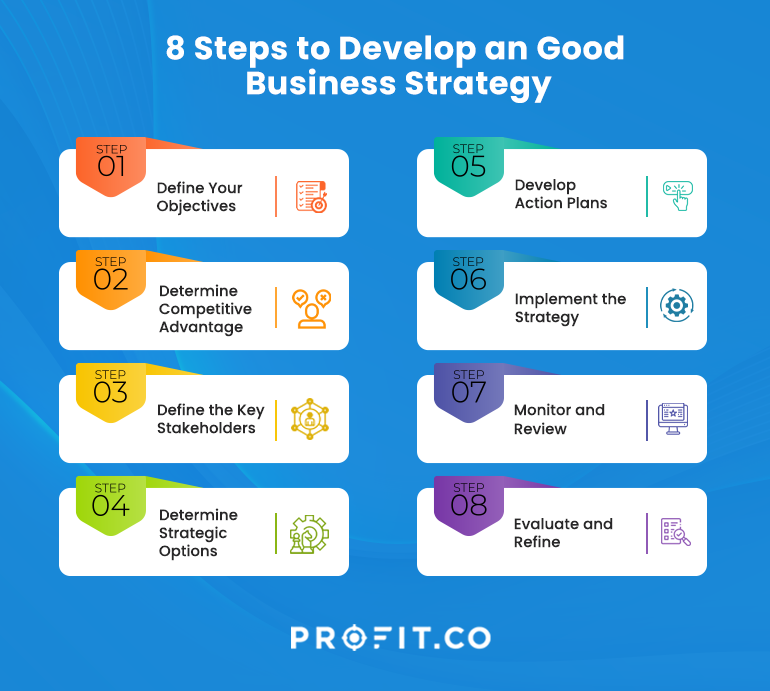In the bustling world of business, strategy is the cornerstone that guides a company toward its desired goals. But what exactly defines a good strategy? And how can one create a good strategy that stands out in this competitive marketplace? This blog will explore the 8 crucial steps to help you develop a robust and successful business strategy.
According to the business world, a strategy is a way of planning and acting to achieve a specific goal or objective. Different strategies exist for different situations, such as business, military, political, or personal. A strategy usually involves analyzing the current situation, identifying the desired outcome, and choosing the best action to reach it.
A good strategy is a plan of action that helps you achieve your goals and objectives in an effective, efficient, and adaptable way. It helps you gain a competitive advantage, increase performance, and grow your business or personal success. Also, it requires allocating resources, such as time, money, people, or materials, and evaluating the results and feedback.
So, to build a good strategy, it is essential to know the difference between a good and a bad strategy. Good Strategy vs. Bad Strategy” delineates the qualities that differentiate effective strategic planning from ineffective or misguided attempts. Understanding the distinction is essential for organizations, leaders, and individuals who aspire to achieve meaningful goals.
Key Considerations for Crafting a Good Strategy
33% of leaders rate their organization as poor or very poor at implementing strategy. So if you wish to formulate a good strategy in your organization, it is essential to understand the key considerations.
Good strategy crafting demands a clear vision, solid research, and ongoing assessment. It’s crucial to start with a well-defined goal, grounding decisions in robust data and diverse insights to avoid assumptions. Address challenges at their core, weigh risks, and align your approach with broader objectives. Engaging with stakeholders, from customers to competitors, ensures a holistic understanding of needs. Continuous evaluation using relevant metrics fine-tunes the strategy. All these elements are intertwined and vital for a holistic strategic plan.
Leaders need to provide strategy and direction and to give employees tools that enable them to gather information and insight from around the world. Leaders shouldn’t try to make every decision.
What are the Components of a Good Strategy?
According to McKinsey, there are four main components of a good strategy
A diagnosis
This is where you define the nature and scope of the challenge you are facing and identify the root causes and key factors that affect it. A diagnosis helps you understand the problem and its context, and avoid superficial or generic solutions.
A guiding policy
This is where you outline the overall approach or direction to address the challenge and its rationale. A guiding policy helps you set your priorities and objectives and align your actions with your values and vision.
A set of coherent actions
This is where you specify the concrete steps or initiatives you will implement to execute your guiding policy and the resources and capabilities you will need. A set of coherent actions helps you translate your strategy into practice and ensure consistency and coordination across different levels and units.
A feedback loop
This is where you monitor and evaluate your progress and performance and make adjustments or corrections as needed. A feedback loop helps you measure your impact and effectiveness and learn from your successes and failures.
6 Questions to ask While Formulating a Strategy
Formulating a strategy is a complex and challenging task that requires careful thinking and planning. There are many questions that you can ask yourself and your team while formulating a strategy, but some of the most common and important ones are listed below.
Here are key questions to ask during the strategy formulation process:
1. What is our vision, mission, and values?
This question helps you define the purpose, direction, and principles of your organization. It also helps you communicate your identity and aspirations to your stakeholders and align your actions with your goals.
2. What are our strengths, weaknesses, opportunities, and threats (SWOT)?
This question helps you analyze your internal and external environment and identify the factors that affect your performance and potential. It also helps you leverage your competitive advantages and address your challenges.
3. What are our objectives, and how will we measure them?
This question helps you set specific, measurable, achievable, relevant, and time-bound SMART goals that guide your strategy. It also helps you track your progress and evaluate your results using key performance indicators (KPIs).
4. What are the alternative courses of action and what are their pros and cons?
This question helps you generate and compare different options for achieving your objectives. It also helps you consider the trade-offs, risks, and uncertainties involved in each option.
5. What is our preferred course of action and why?
This question helps you select the best option for your strategy based on your criteria and analysis. It also helps you justify your choice and explain the logic behind it.
6. How will we implement, monitor, and adjust our strategy?
This question helps you plan the steps, resources, and responsibilities required to execute your strategy. It also helps you establish a feedback loop to review your performance and improve as needed.
By addressing these questions, one can ensure that the strategy is well-thought-out, grounded in reality, and poised for successful implementation.
Ready to Exectue Your Strategy with Precision?
Step-by-step Guide to Developing a Good Strategy
Developing a good strategy requires a systematic approach that aligns with the organization’s vision, mission, and values while addressing the challenges and leveraging the opportunities in the environment.
You are now almost ready to develop your strategy. Hurray!!!! After understanding the key considerations and grasping the details of the components to build a perfect strategy, you can try building a strategy for your organization. Don’t miss to answer the above-listed question before you start developing your strategy.
Here’s a concise guide on developing an good strategy in 8 steps:

1. Define Your Objectives
- Clearly state what you want to achieve.
- Ensure that your objectives are Specific, Measurable, Achievable, Relevant, and Time-bound (SMART).
2. Determine your competitive advantage
- Your competitive advantage is the unique value you offer your customers that sets you apart from your rivals.
- It can be based on factors such as quality, price, innovation, customer service, or social impact
3. Define the Key Stakeholders
- Identify who will be impacted by your strategy.
- Understand their needs, expectations, and potential resistance points.
- You need to understand the external environment in which you operate, including the needs and preferences of your target customers, the competitive landscape, and the trends and challenges that affect your industry.
4. Determine Strategic Options
- Brainstorm possible routes to achieve your objectives.
- Consider alternative approaches, and don’t limit yourself to the obvious choices.
5. Develop Action Plans
- Break down the strategy into actionable steps or tasks.
- It should include the strategies, actions, resources, responsibilities, timelines, and indicators that will guide your plan implementation.
- Try using a Gantt chart or logic model to organize and visualize your plans.
6. Implement the Strategy
- Start executing the action plans.
- Monitor progress regularly and ensure you’re on track to meet the objectives.
7. Monitor and Review
- Track your performance against the set objectives and timelines.
- Use metrics or key performance indicators (KPIs) to measure success.
- Regularly review the strategy to ensure it remains relevant and effective.
8. Evaluate and refine
- You can use tools such as surveys, interviews, focus groups, or data analysis to collect and analyze data for your evaluation after review.
- Based on your evaluation results, you can refine your plan and adjust as needed to ensure continuous improvement.
Examples of Exceptional Strategic Approaches
Strategy can be applied to various domains, such as business, military, politics, education, sports, and more. Strategy can also be classified into different types or levels, depending on the scope, purpose, and context of the plan.
Business Strategy
Apple’s decision to focus on a closed ecosystem where hardware and software are tightly integrated. This allows them to control the user experience and encourage users to purchase within their product ecosystem. By doing so, Apple can optimize the performance of its software for specific hardware configurations, resulting in an often smoother and more cohesive experience for users. Moreover, this controlled environment fosters a sense of brand loyalty and encourages users to stay within the Apple ecosystem for their technology needs.
Marketing Strategy
Coca-Cola uses happiness and global unity in its campaigns to positively associate with its brand and reach a global audience. By associating their beverages with joyous moments, shared experiences, and cross-cultural bonding, they’ve positioned their product as more than just a drink – it becomes a symbol of positivity and togetherness. This strategic branding taps into universal emotions, ensuring relatability across diverse demographic and geographic segments.
Military Strategy
The Greeks used the Trojan Horse during the Trojan War, where they hid soldiers inside a giant wooden horse to gain access to the city of Troy. After a prolonged siege with no victory, the Greeks devised a plan to build a massive wooden horse, hollowed out to secretly house a select group of soldiers. Presenting it as a peace offering, they left the horse at the gates of Troy and feigned retreat. The Trojans, believing they had won and that the horse was a token of Greek surrender, brought it inside their city walls. During the night, the Greek soldiers hidden within the horse emerged, opening the city gates for the rest of the Greek army, which had discreetly returned under darkness. This surprise attack led to the fall of Troy, making the Trojan Horse synonymous with deceit and clever stratagems in warfare and beyond.
Growth Strategy
Netflix’s shift from DVD rental to online streaming, and later, to producing its content to become a dominant player in the entertainment industry.The transition to streaming allowed Netflix to reach a wider audience more efficiently and tap into the growing demand for instant access to content. However, the real game-changer came when they decided to produce their original content. By doing so, Netflix not only differentiated itself from other streaming platforms but also reduced its reliance on external studios and licensing deals.
Investment Strategy
Warren Buffett’s value investing approach focuses on long-term value rather than short-term market fluctuations. At its core, this approach centers on identifying and buying stocks of companies that are undervalued based on intrinsic value calculations, rather than being swayed by transient market trends or speculative bubbles. Buffett emphasizes understanding the business, its fundamentals, and its potential for growth over a prolonged period. He often likens buying stocks to purchasing a piece of a business, emphasizing the importance of believing in the business’s long-term value proposition.
Sports Strategy
A soccer team is playing a “park the bus” strategy, focusing heavily on defense and looking for counter-attacking opportunities. When employing this strategy, teams often look for counter-attacking opportunities. Since the opposing team is pushing forward to break the defense, they might leave gaps at the back, which the defending team can exploit with quick transitions to catch the opposition off-guard. This tactic requires discipline, organization, and stamina from players, as well as efficient communication to ensure defensive solidity and capitalize on counter-attack chances.
Political Strategy
Barack Obama’s 2008 “Change” campaign focused on hope and a new direction for America. His message resonated with various demographics, especially among young voters and diverse racial and ethnic groups, who were eager for a new narrative of inclusivity and optimism. Through inspirational rhetoric, grassroots mobilization, and adept use of emerging digital communication platforms, the campaign galvanized millions. The emphasis on “change” was not just about policies but also symbolized breaking historical barriers, as Obama became the first African-American President of the United States.
Final Thoughts
A robust and good strategy is the cornerstone of any successful business, serving as a guiding beacon for its journey ahead. By following the outlined 8-step process from defining objectives to regularly reviewing and adjusting—the foundation for sustainable growth and adaptability is set. However, the true power of a strategy lies not just in its formulation but in its execution. Businesses must foster a culture of agility, ensuring they’re ready to pivot when necessary and seize opportunities as they arise. In an ever-evolving global market, the commitment to strategic planning and execution is what differentiates the leaders from the followers. Embrace this approach, and your business will be better positioned to navigate challenges and capitalize on prospects.

